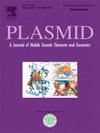Insights from public database sequences related to the replication initiation protein TrfA of the IncP-1 plasmid RK2
IF 2.2
4区 生物学
Q3 GENETICS & HEREDITY
引用次数: 0
Abstract
Replicon typing identifies sequences similar to known DNA replication initiators and is widely used to detect specific plasmid groups (e.g., IncP-1) in genome and metagenome sequencing data. However, the characteristics of these homologous sequences in public databases have not been systematically assessed, making it difficult to determine whether detecting a specific replicon type reliably indicates the presence of a particular plasmid group. Here, we conducted amino acid sequence alignments to identify sequences similar to the replication initiation protein TrfA of the IncP-1 plasmid RK2 in the NCBI non-redundant (nr) database. In the nr nucleotide database, TrfA-matched nucleotide sequences were found across diverse taxonomic groups and replicons, including complete and partial plasmids and chromosomes. In total, 76 protein sequences from the reference plasmid RK2 were screened against the nucleotide sequences of the trfA-harboring plasmids to identify candidate IncP-1 plasmids. TrfA-related proteins, originating from bacterial chromosomes, plasmids, and phages, were selected from the nr amino acid database and used to infer phylogenetic trees. Our phylogenetic analyses reveal that TrfA homologs have diverged through vertical inheritance within IncP-1 and horizontal gene transfer across replicons and taxa. These findings caution against overreliance on single-gene replicon typing to infer plasmid group identity from sequence data.
来自IncP-1质粒RK2复制起始蛋白TrfA的公共数据库序列的见解。
复制子分型识别与已知DNA复制启动子相似的序列,并广泛用于检测基因组和宏基因组测序数据中的特定质粒群(例如IncP-1)。然而,公共数据库中这些同源序列的特征尚未得到系统评估,因此很难确定检测到特定复制子类型是否可靠地表明存在特定的质粒群。在这里,我们进行了氨基酸序列比对,以确定与NCBI非冗余(nr)数据库中IncP-1质粒RK2的复制起始蛋白TrfA相似的序列。在nr核苷酸数据库中,在不同的分类群和复制子中发现了trfa匹配的核苷酸序列,包括完整的和部分的质粒和染色体。从参比质粒RK2中提取76个蛋白序列,与携带trfa的质粒核苷酸序列进行比对,鉴定候选IncP-1质粒。trfa相关蛋白来自细菌染色体、质粒和噬菌体,从nr氨基酸数据库中选择,用于推断系统发育树。我们的系统发育分析表明,TrfA同源物通过IncP-1内部的垂直遗传和复制子和分类群之间的水平基因转移而分化。这些发现提醒人们不要过度依赖单基因复制子分型来从序列数据推断质粒群的身份。
本文章由计算机程序翻译,如有差异,请以英文原文为准。
求助全文
约1分钟内获得全文
求助全文
来源期刊

Plasmid
生物-遗传学
CiteScore
4.70
自引率
3.80%
发文量
21
审稿时长
53 days
期刊介绍:
Plasmid publishes original research on genetic elements in all kingdoms of life with emphasis on maintenance, transmission and evolution of extrachromosomal elements. Objects of interest include plasmids, bacteriophages, mobile genetic elements, organelle DNA, and genomic and pathogenicity islands.
 求助内容:
求助内容: 应助结果提醒方式:
应助结果提醒方式:


